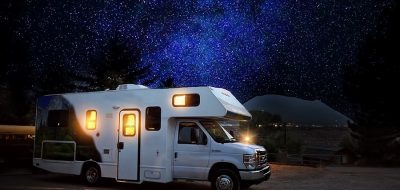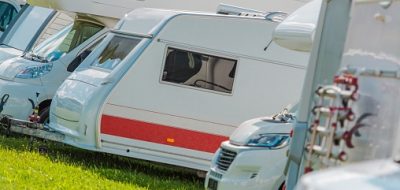Hi, folks! We’ve got a few battery questions this month, and some exterior maintenance tips. Remember to send your RVing questions to [email protected].
Mark:
About 10 days after parking with full batteries, both the house and chassis batteries are at zero volts. Oh yeah, 2008 Damon Daybreak. Suggestions? Robert G
Hi Robert
It sounds like you have some kind of electrical load that is drawing the batteries down. It’s unusual for both the chassis and house batteries to be affected, as they are supposed to be isolated from each other. It’s possible to use a DC ammeter to determine if there is a phantom load drawing power from the batteries when everything is supposed to be off.
It is also possible that the batteries are old/defective, but again, it would be unusual for both the chassis and house batteries to be bad at the same time.
I suggest you disconnect the batteries by removing the cables from the ground (-) side, charge them with an external 12V battery charger, then let them sit for a few days and see if they hold a charge. Use a meter to check them, a fully charged 12V battery should stay stable at around 12.6V. If they do hold a charge, then connect a DC ammeter between the negative battery post and the negative cable you removed. This allows you to read any current draw on the batteries. Current in excess of about 1 amp would indicate that something is drawing power from the batteries that shouldn’t be, and you’ll have to track down the source of that load (or loads). You may need to get a tech involved if this sounds like more than you want, or are able, to do.
Hi Mark, my question has to do with storing RV long term without the capability of tending to the batteries over a long period. I have thought about the low voltage maintenance devices but not being close to the RV I worry about overcharge and possible fire damage should the batteries explode or something…With the batteries losing charge and being recharged I would guess has some bad effects also. Would appreciate your advice, Roy.
Hi Roy
If you have AC power available at the storage site, but you won’t be able to visit the RV and keep an eye on battery water levels, then you’re right to worry about just leaving it plugged in. However, you will need to do something to offset your batteries’ tendency to self-discharge over time. I suggest you disconnect the batteries from the coach so no phantom loads in the coach can run them down, and put a good quality battery maintainer on them. I highly recommend a Schumacher speed/charge battery maintainer and charger. I have 5 of them, and use them on my motorcycles, and passenger vehicles. They really work great, and seem to significantly extend the life of the batteries I use them on. They are intended for long term maintenance use and don’t cause the batteries to lose water, they just keep them at a safe regulated voltage to prevent self-discharge. Another option would be to remove the batteries from the rig and store them indoors in a garage or building that is easy for you to access. When storing deep-cycle batteries outside of the rig, you can use a battery maintainer on them, or just let them set disconnected for 3-4 weeks and then place a portable automotive battery charger on them overnight to bring them up to a full charge. Check the water levels when you charge them.
Mark,
We have 4 “wet cell” batteries for our house batteries on a 2005 Newmar Dutch Star. One cell in one of the batteries is measuring on what I might term marginal, almost in the red, in the hygrometer. All other cells are in the green. These are on constant charge when the RV is parked in storage or, obviously, at a campground. The charging system is a good one and manages the batteries well. I assume we are facing replacement before too long. When I replace these, I would like to use a battery that does not need to have the water level maintained. Could you recommend batteries (distributors, type, and manufacturers) which would replace these and fit within the same space as the current batteries? These batteries share a roll out with the two sealed batteries that service the non-coach house, motor, etc. We do very little camping where there isn’t 120-volt service available. Thanks, Everett
Hi, Everett,
If your batteries are five or more years old, they are probably approaching the end of their service life and should be replaced. Your hygrometer readings are showing that at least one battery is compromised, and all 4 are probably getting tired. It’s best to replace all 4 batteries as a set, to keep them matched as closely as possible. If you want a truly maintenance-free battery, the one I would recommend for RV use is an AGM (Absorbed Glass Mat) battery. They are 100 percent sealed, and require no maintenance at all. They are also true deep-cycle batteries and will last 4-8 years in typical RV service. I have included a few web links for vendors. These batteries are a bit pricey, so if you truly do very little dry-camping, you might want to consider only installing two batteries instead of four. This will reduce your ability to camp without hookups but should be enough to power critical systems on your coach for a single night’s stop. This may be a good choice if you always plug in at a campground. You can start with just one pair, and if you find that you need additional capacity, easily add a second pair.
http://www.lifelinebatteries.com/
http://www.advancedpowerproducts.com/
Mark, we store our RV in a lot in our complex, and the decals on the side that gets the most sun have cracked. Is there any quick fix to make these look better barring taking them off? Thanks. I love reading your column. Kathy
Hi, Kathy,
Most RV decals are vinyl, and the only way to keep them looking good is to keep a good quality automotive paste wax on them to help protect them from the sun and from drying out. Unfortunately, once the decals have begun to crack and fade, there is very little you can do to restore them. There are some polymer coatings that are used to rejuvenate painted surfaces that may be worth a try. Take a look at www.vivilon.com. They offer a clear coating that can be applied to just about any surface to restore its color and shine. I have never used it, but it may do the trick for you. (If you try it and it works, please let me know!) Another alternative is to remove the old decals and replace them. There are a number of companies that specialize in replacement graphics and decals for RVs. Take a look at
Removing the old graphics is a difficult task and may be best left to professionals. However, if you have near-infinite patience and a heat gun, they can be removed using a plastic or steel scraper, some heat, and a gentle touch. Of course, the third alternative is to develop a blind spot and just not see the faded decals. That approach has worked well for me in the past! (smile)
Hi Mark:
Happy New Year to you and your family!! I always appreciate your articles! I have a quick question: I have a very thin cut (slice) that is 2 inches long in the fiberglass of my Thor Palazzo. Is there a good (and easy) way to seal this cut? Best regards, Mike
Hi Mike
I’ve had the same problem, and discovered that you really have two choices on repair method. If sealing the damaged area is your primary concern, then there’s nothing better than Eternabond tape. http://www.eternabond.com/RV-Leak-Repair-Products-s/22.htm It will be a permanent water-tight repair, but will not be esthetically pleasing. If the spot is very visible, and you’re concerned with how it looks, then it gets a bit harder. Putting a clear sealant on the crack sounds like a good idea, and it blends in nicely with the paint or finish, but I haven’t found any clear liquid sealant that won’t yellow or discolor over time. One possibility is to seal the crack with a good polyurethane sealant, smooth it out carefully, then put a decal or small light fixture, or other exterior accessory over the repair once it’s set up. This hides the repair from the eye. It’s also possible to repair the crack with automotive body repair materials, sand it down, fill and prime it, and then paint it, but paint matching is best left to professional repair shops, as it’s really hard for a do-it-yourselfer to paint match and feather a repair and get it to blend in. Hope that helps!

Founded in 1978, the Escapees RV Club provides a total support network that includes a wide variety of services and opportunities:
- Mail Service- Escapees offers the largest private mail service in the country. Members are able to personalize their mail delivery with multiple options. Custom sorting options, delivery schedule and even mail scanning. We make it easy!
- Mapping Tool- Plug in your starting point and destination, and let us do the rest! Our mapping tool will show you discount parks along your route, as well as trusted commercial members and endorsed vendors to help you with all of your needs along the way.
- Education- From our annual Escapades to our discussion forum, we help you connect with fellow RVers to share experience and knowledge. For the hands-on learner, RVers’ Boot Camp is a great way to learn about RV operation, safety and maintenance. Our award-winning magazine is also a great resource for peer-to-peer advice from fellow RVers and industry experts.
- Community- When you see an Escapees sticker on a rig, you know you’ve found a friend. Escapees hosts a variety of events throughout the year, including convergences, excursions, chapter rallies and Escapade. Each of these offers the opportunity to connect with other RVers and make new friends.









